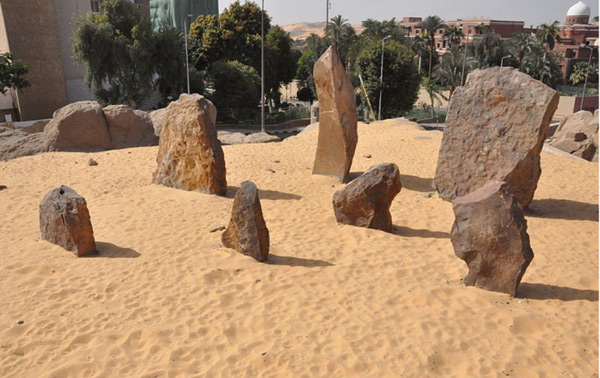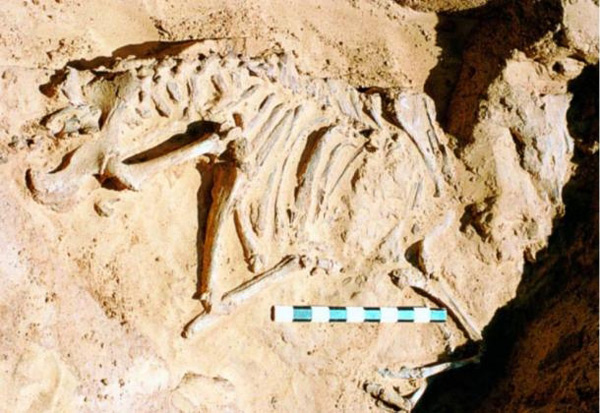Nabta Playa - The burial place of mysteries about an ancient Egyptian civilization
Nabta Playa is a remarkable archaeological site consisting of hundreds of prehistoric tombs, inscriptions, and megalithic structures located in the Nubian desert, about 100 km west of Abu Simbel in southern Egypt. They are what remains of an advanced urban community that originated about 11,000 years ago .
Discover the pre-Egyptian civilization
The megalithic blocks can be found in a number of separate clusters, arranged in a direction that is almost north-south. In the nearest northern region of the archaeological site, there is a group of about 12 megaliths (mound and rock placed on a grave) made of sandstone, and they are found to contain the remains of cattle.

The megaliths at Nabta Playa are displayed in the Aswan Nubia museum's garden.
The grave of cattle
Most of the tombs in the cluster are made up of stone of no specific shape containing piles of bones of cattle, goats and sheep. However, one of the graves is very striking compared to the rest, it is larger and has an iron frame around it when digging into the ground. Inside, archaeologists found the remains of a calf, dating back to 7,400 years . The cow is buried by rubble forming a mound with a diameter of 8m and 1m high.
This finding is significant because the remains of cattle and tomb construction show them that these are animals that have been sacrificed for sacrifice , and people have put a lot of effort into burial.
The practice of ritual rituals often involves belief in one or more certain deities, and incorporates this discovery with the alignment of megaliths and stone circles, which shows that Nabta Playa may be a regional ritual center , something unprecedented in Africa at that time.

The remains of a calf are found in a room under a tomb.(Image source: Romuald Schild)
Although many similar megalithic structures have been found in other areas, they are more recent than those found in Nabta Playa.
The mystery of table stones
An important feature of Nabta Playa is a series of small megalithic rock complexes built directly on the stone tables. Stone tables are large mushroom-shaped rocks that are naturally formed by erosion. For thousands of years, they have been buried under a few meters of clay and mud, so a question that scientists have been very confused about is how Nabta Playa people find them?
Because I couldn't see the signs of these rocks at that time. One hypothesis was that they discovered them by chance while digging a well, but there would have been so many coincidences for many stone tables following this theory.
When the location was determined, the people of Nabta Playa would place the stone table convex and a straight face to the north. Then they put the other big stones upright on the stone tablet, some believe they are sculpted to look like a big cow or animal. Some other stones were placed to hold the 'sculpture' in place and the later holes were filled with sediment. Scientists believe that these 'sculptures ' date to between 5,500 and 5,000 years.
Testing has been conducted using carbon methods around architectures, although this is not a method that provides sufficient evidence.

Pull a board up from a hole.(Source: Romuald Schild)
The reason why the ancient people created these unusual structures has not been clarified. They may have some useful function, like a stone calendar circle or they may describe something of great significance at that time. Perhaps more excavations will reveal more secrets of this unusual place.
The end of Nabta civilization and the emergence of major cities by the Nile
About 5,000 years ago, the civilization of megalithic builders in Nabta Playa collapsed when climate change and desert deaths returned to the area again. Residents of this place must move to live in another area that can be accommodated, but the question remains, where did they go?
Some archaeologists, such as J McKim Malville, believe that Nabta's people go to the Nile valley, stimulating the growth and development of the major cities on the Nile and then the emergence of Egypt.
'Within 500 years after the migration from Nabta, the terraced pyramid at Saqquara has been built, indicating that there has been a culture from before, maybe it originated in the desert regions. Upper Egypt. An exodus from the Nubian desert from 5,000 years ago has spurred the development of a stratified society in the previous culture due to the emergence of a better organized group of nomads and possessing many knowledge of dance. more complex cosmology '. (Malville, Wendorf, Mazar & Schild, 1998)
According to Schild and Wendorf, there is enough evidence to show that at least some of the Egyptian, magic, and religious beliefs originated from the people of Nabta Playa. For example, some steles in Nabta Playa are aligned with the brightest star of the North Star in the Big Bear constellation.
As noted, this star is also very important in the cosmology of ancient Egypt . Furthermore, the three megaliths of the Nabta Playa's stone calendar are thought to symbolize the constellation of Heavenly Orion (Orion), the constellation that plays an important role in astronomy of ancient Egypt. Wendorf and Schild (2004) have pointed out another interesting feature:
'Perhaps the most convincing link between ancient Egyptian mythology and religion and buried animals in the desert southwest is the group of Nabta Basin steles. The steles here face towards the pole in the sky. According to documents in the Egyptian morgue called the Pyramid, this is a place where stars never die and where there is no death. '
A series of links between complex and structured societies has evolved over thousands of years in the Nubian desert , and the ancient cities of the Nile River of ancient Egypt, show the emergence of strong civilization. the power and prestige of ancient Egypt lasted longer than originally planned.
- The 4,000-year-old burial room of the ancient Egyptian official
- Add new findings from ancient Egyptian mummies
- Things that make you see how great the ancient Egyptians were
- Another amazing thing about ancient Egyptian civilization
- Excavation of ancient Egyptian tombs 2300 years old - at least 17 high-level mummies were found
- 10 thrilling things about Maya civilization
- New timeline for the beginning of ancient Egypt
- The ancient Egyptian tomb may contain the forgotten pharaoh's corpse
- Discovered an ancient disc at the place of the burial of King Quang Trung
- The mystery of bore holes in ancient Egypt
- Discovery of 10,000-year-old civilization traces on the seabed
- Mysterious legends about ancient Egypt
 'Fine laughs' - Scary and painful torture in ancient times
'Fine laughs' - Scary and painful torture in ancient times The sequence of numbers 142857 of the Egyptian pyramids is known as the strangest number in the world - Why?
The sequence of numbers 142857 of the Egyptian pyramids is known as the strangest number in the world - Why? Miracle behind the world's largest stone Buddha statue
Miracle behind the world's largest stone Buddha statue What is alum?
What is alum?